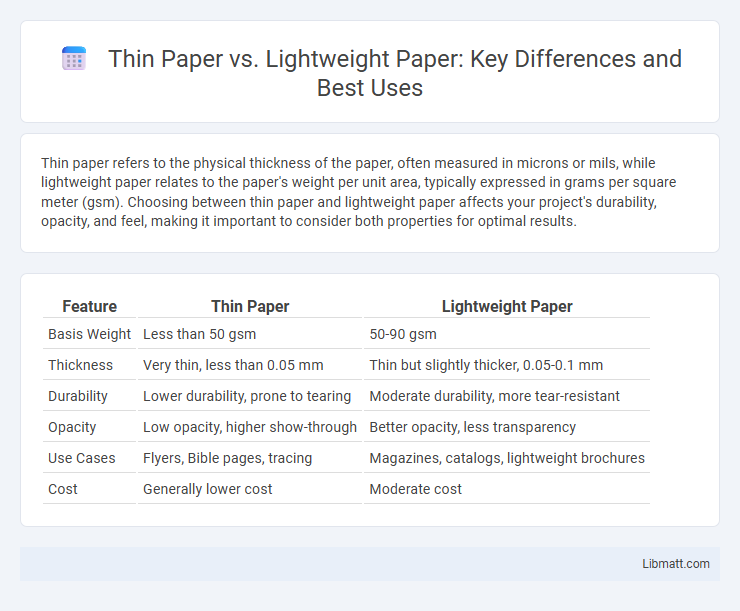Thin paper refers to the physical thickness of the paper, often measured in microns or mils, while lightweight paper relates to the paper's weight per unit area, typically expressed in grams per square meter (gsm). Choosing between thin paper and lightweight paper affects your project's durability, opacity, and feel, making it important to consider both properties for optimal results.
Table of Comparison
| Feature | Thin Paper | Lightweight Paper |
|---|---|---|
| Basis Weight | Less than 50 gsm | 50-90 gsm |
| Thickness | Very thin, less than 0.05 mm | Thin but slightly thicker, 0.05-0.1 mm |
| Durability | Lower durability, prone to tearing | Moderate durability, more tear-resistant |
| Opacity | Low opacity, higher show-through | Better opacity, less transparency |
| Use Cases | Flyers, Bible pages, tracing | Magazines, catalogs, lightweight brochures |
| Cost | Generally lower cost | Moderate cost |
Understanding Thin Paper and Lightweight Paper
Thin paper typically refers to paper with a low caliper measurement, usually under 50 gsm (grams per square meter), emphasizing its slim, delicate nature often used for magazines, Bible pages, or maps. Lightweight paper, on the other hand, focuses on the paper's weight category, generally falling between 40 to 90 gsm, designed to reduce bulk while maintaining adequate strength and opacity, suitable for flyers and brochures. Both types prioritize reduced thickness and weight but differ in specific applications and strength characteristics based on their gsm ratings and usage requirements.
Key Differences Between Thin and Lightweight Paper
Thin paper is primarily characterized by its reduced thickness, usually measured in microns or GSM (grams per square meter), making it more delicate and translucent compared to lightweight paper. Lightweight paper, while also less dense, emphasizes a lower basis weight but can vary in thickness and durability, offering better strength and opacity than thin paper. Your choice depends on the application: thin paper suits tasks requiring transparency or flexibility, while lightweight paper delivers a balance of lightness and sturdiness for printing or packaging needs.
Common Uses of Thin Paper
Thin paper is commonly used for applications requiring flexibility and minimal weight, such as tracing paper, cigarette rolling papers, and lightweight maps. Its thinness allows for easy folding and layering, making it ideal for art projects, origami, and delicate book pages. You will often find thin paper in business forms, newspapers, and disposable products where cost-efficiency and portability are essential.
Typical Applications of Lightweight Paper
Lightweight paper is commonly used for applications such as mass mailings, flyers, catalogs, and book inserts due to its balance of durability and reduced shipping costs. It is favored in packaging for wrapping delicate items and in stationery for notepads and brochures where a lighter feel is preferred. Compared to thin paper, which is often used in specialty fields like archival documents or tracing, lightweight paper offers more versatility for everyday commercial and printing purposes.
Thickness and Weight Comparison
Thin paper typically refers to sheets with lower thickness measured in microns or mils, whereas lightweight paper is classified by its basis weight, often below 50 gsm. Thickness directly influences the paper's opacity and feel, with thin paper offering a sleeker profile suited for applications like Bible pages, while lightweight paper balances durability and reduced mass for ease of handling in bulk printing. You should consider both thickness and weight to ensure your printing project achieves the desired quality and functionality.
Durability and Strength: Thin vs Lightweight Paper
Thin paper typically features a lower basis weight, which can compromise durability and strength compared to lightweight paper designed with reinforced fibers for enhanced resilience. Lightweight paper balances reduced thickness with improved tensile strength, making it more resistant to tearing and wear during handling and printing processes. Choosing lightweight paper ensures better performance in applications requiring both a delicate feel and structural integrity.
Print Quality on Thin and Lightweight Paper
Print quality on thin paper often reveals sharper details and vibrant colors due to its smooth surface and minimal fiber density, enhancing image clarity and text crispness. Lightweight paper, while slightly thicker, offers better durability but may result in subtle ink absorption variations that can affect fine detail reproduction and color intensity. When selecting your paper, consider the balance between print sharpness and material sturdiness to achieve optimal results for your specific printing needs.
Environmental Impact and Sustainability
Thin paper and lightweight paper both contribute to environmental sustainability by reducing raw material usage and lowering transportation emissions due to their reduced mass. Thin paper, typically characterized by lower basis weight and thickness, offers greater material efficiency but may be less durable, influencing product lifespan and waste generation. Lightweight paper balances strength and resource conservation, potentially enhancing recyclability and minimizing environmental impact compared to thicker paper alternatives.
Cost Considerations for Thin and Lightweight Paper
Thin paper generally offers significant cost savings due to reduced material usage and lower shipping weights compared to heavier stocks. Lightweight paper, while slightly thicker, balances cost-efficiency with improved durability and print quality, often making it a preferred choice for budget-conscious projects requiring greater longevity. Evaluating the total expense involves considering not only the purchase price but also handling, transportation, and durability requirements specific to the intended application.
Choosing the Right Paper for Your Needs
Choosing the right paper depends on your specific project requirements, as thin paper offers excellent translucency and flexibility ideal for tracing or lightweight crafting. Lightweight paper, often measured by weight such as 60-80 GSM, provides durability and ease of handling for printing and bulk writing tasks. Understanding the balance between thickness, weight, and intended use ensures your project achieves optimal results with minimal waste.
thin paper vs lightweight paper Infographic

 libmatt.com
libmatt.com